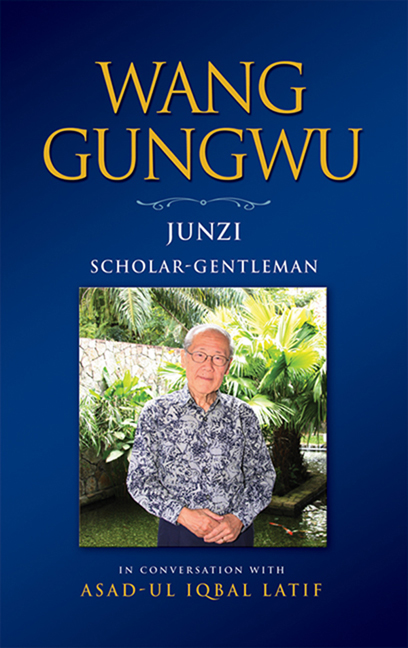Book contents
- Frontmatter
- Contents
- Foreword
- Wang Gungwu: Friend, Mentor and Role Model
- Junzi: Scholar-Gentleman
- INTERVIEWS WITH PROFESSOR WANG GUNGWU
- Being Chinese in Malaya
- Malaysia, Singapore and Australia
- Vietnam
- Hong Kong
- China Rising
- Taiwan, Japan and India
- The United States, Terrorism and War
- Half a Century of Marriage: An Interview with Mrs Margaret Wang
- Appendices
- Index
- Plate Section
China Rising
from INTERVIEWS WITH PROFESSOR WANG GUNGWU
Published online by Cambridge University Press: 09 November 2017
- Frontmatter
- Contents
- Foreword
- Wang Gungwu: Friend, Mentor and Role Model
- Junzi: Scholar-Gentleman
- INTERVIEWS WITH PROFESSOR WANG GUNGWU
- Being Chinese in Malaya
- Malaysia, Singapore and Australia
- Vietnam
- Hong Kong
- China Rising
- Taiwan, Japan and India
- The United States, Terrorism and War
- Half a Century of Marriage: An Interview with Mrs Margaret Wang
- Appendices
- Index
- Plate Section
Summary
You have written about the fourth rise of China in the 20th century, after the Qin-Han unification of the first bureaucratic empire that lasted from the 3rd century BC to the 3rd century AD; the Sui-Tang reunification; and the Ming and Qing dynasties. Do you expect China's fourth rise to be resilient?
When I used the words, “fourth rise”, I was struck by the fact that China had finally overcome its period of decline. Historical analogies are useful for us to think in the very long terms, in which the Chinese people like to think anyway. China went through many periods of tumultuous disorganization, breakdown and break-up when the Chinese people were extremely weak and were hemmed in from all sides. But even during the long periods of division, there seemed always to have been the possibility of the Chinese reorganizing themselves and getting off the ground again as a unitary state.
The Han Dynasty represents about 300 years of great success followed by more than 300 years of division. After its breakdown, it was entirely possible for China to have become many different countries. There were many kingdoms and little empires, but it was basically a north-south divide, with the Yangtse River as the great divider. There were several dynasties in the north, and in the south. Eventually, the whole country came together again. How that happened is very dramatic. Underlying all those periods of division and brutal and deadly battles fought between so-called Chinese and so-called non- Chinese was the thread that they were fighting for the unity of China. That was ideological, the ideology being that there is only one heaven in the sky, there is only one sun in the sky. Hence, division is only temporary. So when unity was achieved, it was not something unexpected or unusual.
This took a long time to happen. When the Sui and then the Tang united the two halves of China after nearly 400 years of division, it was one sun in the sky again. In the rhetoric of all the Chinese thinkers, this was a glorious period when there were no longer civil wars. They stopped fighting each other and served one ruler for one ideal and one set of values.
- Type
- Chapter
- Information
- Wang GungwuJunzi: Scholar-Gentleman in Conversation with Asad-ul Iqbal Latif, pp. 75 - 106Publisher: ISEAS–Yusof Ishak InstitutePrint publication year: 2010

